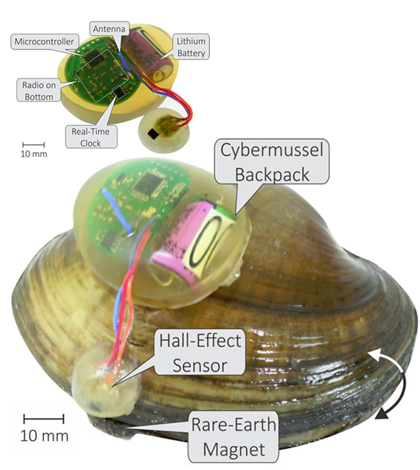Cybermussels With Electronic Packs Provide Nitrogen Insights

Components of the backpack include a magnetic sensor that will detect if the mussel is open or closed; a microcontroller to manage the data; a clock; a radio and antenna to transmit data; a custom 3D-printed housing for the electronics; and a battery to power the device. (Credit: University of Iowa)
Harmful nitrate levels plague large portions of the Mississippi River watershed. These are transported down the waterway and then centralize in the Gulf of Mexico, where they contribute to massive dead zones that leave areas of the Gulf with depleted oxygen levels and fish kills. For years, scientists have been studying this problem and have been coming at it using the latest technology of the day. For those at the University of Iowa attacking the issue, technology is at the forefront of their approach but they’re just deploying it differently — by mounting it on freshwater mussels. Their plan is to outfit these cybermussels with electronic monitors that can track nitrates in the river’s water.
“We want to fit a mussel with a little backpack and set them free,” said Anton Kruger, professor of electrical engineering at the university, in a video. “So that they can roam in their environment, reproduce. But to do that, we have to do a number of things.”
They are first testing the idea in the lab and then hope to scale it up if it works out well. Some things they are tackling along the way include making the electronics small enough to not inhibit the mussels’ natural movements; ensuring that the monitoring package is watertight; and guaranteeing that all the data gathered can be easily downloaded.
From that point, researchers would go out and gather wild pocketbook mussels from the Iowa River, glue the packs to their shells and then release them back into the wild. The packs would be 3D-printed and outfitted with microcontrollers, antennas, radio transmitters and sensors that would let scientists know when the mussels had their shells closed or open.

Several mussels in a slow-moving community would be outfitted with backpacks. Each mussel would act as a node in a short-hop radio system, eventually communicating signals to a base station with a cellular link to remote servers. (Credit: University of Iowa)
The mussels would be placed in small communities so that radio transmission between them would be possible, relaying in a chain to data loggers that would broadcast findings via cellular telemetry to researchers on land.
The data would show when the mussels have their shells open or closed, which is important because they essentially only open if water quality is good enough for them to do so. If there is a change in the rhythmic opening and closing of the mussels’ valves, then scientists know that there has been a change in their surrounding environment.
“Mussels have patterns in their gape response. So putting these sensor packs on the mussels where we can measure things like their gape motion or their heart rate — that gives us our first indicator of whether or not our mussels are thriving,” said Craig Just, assistant professor of civil and environmental engineering at the university, in the video. “Gape response can also be interrupted. A flood happens, or a toxic substance comes in their midst. They literally, as the phrase goes, they clam up.”
So in the context of researching the nitrogen cycle of the Mississippi River watershed, using mussels as living water quality sensors can be quite valuable. When populations are healthy, scientists say that mussels and the bacteria they interact with can transfer large amounts of nitrogen from waterways into the sediment of a riverbed, thus preventing nitrogen from reaching the Gulf.
“The National Academy of Engineering has called managing the nitrogen cycle one of the 14 grand challenges of engineering,” said Just, in the video. “And so these organisms play a huge role in that. And the way they couple with the way other organisms like bacteria function, it could be some of our engineering solution for nitrogen management issues in the future.”
Top image: Components of the backpack include a magnetic sensor that will detect if the mussel is open or closed; a microcontroller to manage the data; a clock; a radio and antenna to transmit data; a custom 3D-printed housing for the electronics; and a battery to power the device. (Credit: University of Iowa)




zidane
September 7, 2022 at 2:56 am
very clear and good article easy to understand. Thank you